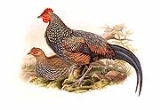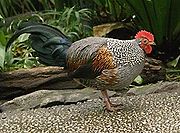
Grey Junglefowl
Encyclopedia
The Grey Junglefowl also known as Sonnerat's Junglefowl, is a wild relative of domestic fowl that is endemic to India
. This species is found mainly in peninsular India and where it overlaps with the distribution of the Red Junglefowl
, it is known to form hybrids. The calls are loud and distinctive and they are hunted for meat and the long neck hackle feathers that are sought after for making fishing lures.
. The male has red wattles and combs but not as strongly developed as in the Red Junglefowl
. Legs of males are red and have spurs while the yellow legs of females usually lack spurs. The central tail feathers are long and sickle shaped. Males have an eclipse plumage in which they moult their colourful neck feathers in summer during or after the breeding season. The female is duller and has black and white streaking on the underparts and yellow legs. They are found in thickets, on the forest floor and open scrub. Their loud calls of Ku-kayak-kyuk-kyuk can be heard in the early mornings and at dusk. Unlike the Red Junglefowl, the male does not flap its wing before uttering the call. They forage in small mixed or single sex groups. They breed from February to May. They lay 4 to 7 eggs which are pale creamy in a scrape. Eggs hatch in about 21 days. Although mostly seen on the ground, Grey Junglefowl fly into trees to escape predators and to roost.
They feed on grains including bamboo seeds, berries, insects and termites.
The populations from the Mt. Abu region of Rajasthan named as subspecies wangyeli is usually not recognized although it is said that the calls of the cock from this region differs from the call of birds from southern India and the plumage is much paler.
The species epithet commemorates the French explorer Pierre Sonnerat
. Local names include Komri in Rajasthan, Geera kur or Parda komri in Gondi, Jangli Murghi in Hindi, Raan kombdi in Marathi, Kattu Kozhi in Tamil and Malayalam, Kaadu koli in Kannada and Tella adavi kodi in Telugu.
overlap slightly along the northern boundary of the distribution although the ranges are largely non-overlapping.
 The Grey Junglefowl is found mostly in Peninsular India, while the Red Junglefowl is found more along the foothills of the Himalayas. A region of overlap occurs in the Aravalli range. The species has been isolated by a variety of mechanisms including behavioural differences and genic incompatibility but hybridization is not unknown. Some phylogenetic studies of Junglefowl show that this species is more closely related to the Ceylon Junglefowl Gallus lafayetii
The Grey Junglefowl is found mostly in Peninsular India, while the Red Junglefowl is found more along the foothills of the Himalayas. A region of overlap occurs in the Aravalli range. The species has been isolated by a variety of mechanisms including behavioural differences and genic incompatibility but hybridization is not unknown. Some phylogenetic studies of Junglefowl show that this species is more closely related to the Ceylon Junglefowl Gallus lafayetii
than to the Red Junglefowl, Gallus gallus but another study shows a more ambiguous position due to hybridization. An endogenous retroviral DNA sequence, of the EAV-HP group noted in domestic fowl is also found in the genome of this species pointing to the early integration of the virus DNA into the genome of Gallus.
A study in southern India found a density of 19.8 groups per square kilometer (but ranging from 1.67 to 34.42 in dry deciduous forests on plains) with an average group size of 1.3. The male to female ratio was 1:1.2 and the preferred habitat was low to moderate canopied forest with low or no grass cover.
They are threatened by hunting for food and habitat loss. Feather use in fly-fishing has also been suggested as a threat.
India
India , officially the Republic of India , is a country in South Asia. It is the seventh-largest country by geographical area, the second-most populous country with over 1.2 billion people, and the most populous democracy in the world...
. This species is found mainly in peninsular India and where it overlaps with the distribution of the Red Junglefowl
Red Junglefowl
The Red Junglefowl is a tropical member of the Pheasant family. They are thought to be ancestors of the domestic chicken with some hybridisation with the Grey Junglefowl...
, it is known to form hybrids. The calls are loud and distinctive and they are hunted for meat and the long neck hackle feathers that are sought after for making fishing lures.
Description
The male has a black cape with ochre spots and the body plumage on a gray ground colour is finely patterned. The elongated neck feathers are dark and end in a small, hard, yellowish plate; this peculiar structure making them popular for making high-grade artificial fliesArtificial fly
An artificial fly or fly lure is a type of fishing lure, usually used in the sport of fly fishing . In general, artificial flies are the bait which fly fishers present to their target species of fish while fly fishing...
. The male has red wattles and combs but not as strongly developed as in the Red Junglefowl
Red Junglefowl
The Red Junglefowl is a tropical member of the Pheasant family. They are thought to be ancestors of the domestic chicken with some hybridisation with the Grey Junglefowl...
. Legs of males are red and have spurs while the yellow legs of females usually lack spurs. The central tail feathers are long and sickle shaped. Males have an eclipse plumage in which they moult their colourful neck feathers in summer during or after the breeding season. The female is duller and has black and white streaking on the underparts and yellow legs. They are found in thickets, on the forest floor and open scrub. Their loud calls of Ku-kayak-kyuk-kyuk can be heard in the early mornings and at dusk. Unlike the Red Junglefowl, the male does not flap its wing before uttering the call. They forage in small mixed or single sex groups. They breed from February to May. They lay 4 to 7 eggs which are pale creamy in a scrape. Eggs hatch in about 21 days. Although mostly seen on the ground, Grey Junglefowl fly into trees to escape predators and to roost.
They feed on grains including bamboo seeds, berries, insects and termites.
The populations from the Mt. Abu region of Rajasthan named as subspecies wangyeli is usually not recognized although it is said that the calls of the cock from this region differs from the call of birds from southern India and the plumage is much paler.
The species epithet commemorates the French explorer Pierre Sonnerat
Pierre Sonnerat
Pierre Sonnerat was a French naturalist and explorer.Sonnerat was the nephew of the botanist Pierre Poivre. He made several voyages to southeast Asia, visiting the Philippines and Moluccas between 1769 and 1772, and India and China from 1774 to 1781. He was the first person to give a scientific...
. Local names include Komri in Rajasthan, Geera kur or Parda komri in Gondi, Jangli Murghi in Hindi, Raan kombdi in Marathi, Kattu Kozhi in Tamil and Malayalam, Kaadu koli in Kannada and Tella adavi kodi in Telugu.
Distribution
The species is mainly in the Indian Peninsula but extends into Gujarat, Madhya Pradesh and south Rajasthan. This species and the Red JunglefowlRed Junglefowl
The Red Junglefowl is a tropical member of the Pheasant family. They are thought to be ancestors of the domestic chicken with some hybridisation with the Grey Junglefowl...
overlap slightly along the northern boundary of the distribution although the ranges are largely non-overlapping.
Evolution and status

Sri Lanka Junglefowl
The Sri Lankan Junglefowl , also known during the colonial era as the Ceylon Junglefowl, is a member of the pheasant family which is endemic to Sri Lanka, where it is the national bird. It is closely related to the Red Junglefowl , the wild junglefowl from which the chicken was domesticated...
than to the Red Junglefowl, Gallus gallus but another study shows a more ambiguous position due to hybridization. An endogenous retroviral DNA sequence, of the EAV-HP group noted in domestic fowl is also found in the genome of this species pointing to the early integration of the virus DNA into the genome of Gallus.
A study in southern India found a density of 19.8 groups per square kilometer (but ranging from 1.67 to 34.42 in dry deciduous forests on plains) with an average group size of 1.3. The male to female ratio was 1:1.2 and the preferred habitat was low to moderate canopied forest with low or no grass cover.
They are threatened by hunting for food and habitat loss. Feather use in fly-fishing has also been suggested as a threat.
Other sources
- Tehsin,Raza H (1988) Inducing sleep in birds. J. Bombay Nat. Hist. Soc. 85(2):435-436.
- Chitampalli,MB (1977) Occurrence of Grey Junglefowl and Red Junglefowl together. J. Bombay Nat. Hist. Soc. 74(3):527.
- Abdulali,Humayun (1957) The Grey Junglefowl in Salsette. J. Bombay Nat. Hist. Soc. 54(4):946.
- Tehsin,Raza; Tehsin,Fatema (1990) Jungle Cat Felis chaus and Grey Junglefowl Gallus sonneratii. J. Bombay Nat. Hist. Soc. 87(1):144.
- Morris,RC (1927) A jungle fowl problem. J. Bombay Nat. Hist. Soc. 32(2):374.
- Ali,S (1968) The case of the Indian Grey Junglefowl. Newsletter for BirdwatchersNewsletter for BirdwatchersNewsletter for Birdwatchers is an Indian periodical of ornithology and birdwatching founded in 1960 by Zafar Futehally, who edited it until 2003. It was initially mimeographed and distributed to a small number of subscribers each month. The editorial board in its early years included Salim Ali,...
. 8(5):5-6. - Subramanian,C; Kambarajan,P; Sathyanarayana,MC (2001) Roosting tree preference by Grey Junglefowl, (Gallus sonneratti) at Theni Forest Division, Western Ghats, Tamil Nadu, south India. Mor 4(February), 9:11.
- Zacharias,VJ (1993) Grey Jungle Fowl in Kerala. WPA-India News 1(1):9-10.

